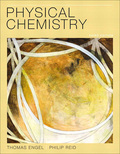
EBK PHYSICAL CHEMISTRY
3rd Edition
ISBN: 9780133556094
Author: Reid
Publisher: YUZU
expand_more
expand_more
format_list_bulleted
Question
Chapter 1, Problem 1.16NP
Interpretation Introduction
Interpretation: The volume of oxygen needed at STP to
Concept introduction:
An ideal gas follows the
Where
P is pressure of gas
V- Volume occupied by the gas
n- Moles of the gas
R- Universal gas constant
T- Temperature
Expert Solution & Answer
Want to see the full answer?
Check out a sample textbook solution
Students have asked these similar questions
Can I please get help with identifying these?
4. Calculate the pH of a 0.10 M acetic acid (CH3COOH) solution if the Ka of acetic acid = 1.8 x 10-5
Draw the Zaitsev product of the dehydration of this alcohol.
+
I
X
5
OH
ざ~
TSOH
Click and drag to start
drawing a structure.
Chapter 1 Solutions
EBK PHYSICAL CHEMISTRY
Ch. 1 - Prob. 1.1CPCh. 1 - Prob. 1.2CPCh. 1 - Prob. 1.3CPCh. 1 - Prob. 1.4CPCh. 1 - Prob. 1.5CPCh. 1 - Prob. 1.6CPCh. 1 - Prob. 1.7CPCh. 1 - Prob. 1.8CPCh. 1 - Prob. 1.9CPCh. 1 - Prob. 1.10CP
Ch. 1 - Prob. 1.11CPCh. 1 - Prob. 1.12CPCh. 1 - Prob. 1.13CPCh. 1 - Prob. 1.14CPCh. 1 - Prob. 1.15CPCh. 1 - Prob. 1.1NPCh. 1 - Prob. 1.2NPCh. 1 - Prob. 1.3NPCh. 1 - Prob. 1.4NPCh. 1 - Prob. 1.5NPCh. 1 - Prob. 1.6NPCh. 1 - Prob. 1.7NPCh. 1 - Prob. 1.8NPCh. 1 - Prob. 1.9NPCh. 1 - Prob. 1.10NPCh. 1 - Prob. 1.11NPCh. 1 - Prob. 1.12NPCh. 1 - Prob. 1.13NPCh. 1 - Prob. 1.14NPCh. 1 - Prob. 1.15NPCh. 1 - Prob. 1.16NPCh. 1 - Prob. 1.17NPCh. 1 - Prob. 1.18NPCh. 1 - Prob. 1.19NPCh. 1 - Prob. 1.20NPCh. 1 - Prob. 1.21NPCh. 1 - Prob. 1.22NPCh. 1 - Prob. 1.23NPCh. 1 - Prob. 1.24NPCh. 1 - Prob. 1.25NPCh. 1 - Prob. 1.26NPCh. 1 - Prob. 1.27NPCh. 1 - Prob. 1.28NPCh. 1 - Prob. 1.29NPCh. 1 - Prob. 1.30NPCh. 1 - Prob. 1.31NPCh. 1 - Prob. 1.32NPCh. 1 - Prob. 1.33NPCh. 1 - Prob. 1.34NPCh. 1 - Prob. 1.35NPCh. 1 - Prob. 1.36NPCh. 1 - Prob. 1.37NPCh. 1 - Prob. 1.38NPCh. 1 - Prob. 1.39NPCh. 1 - Prob. 1.40NP
Knowledge Booster
Similar questions
- Please help with identifying these.arrow_forwardFor the reaction: CO2(g) + H2(g) --> CO (g) + H2O (g) Kc= 0.64 at 900 degrees celcius. if initially you start with 1.00 atmoshpere of carbon dioxide and 1 atmoshpere of hydrogen gas, what are the equilibrium partial pressuses of all species.arrow_forwardCan I please get this answered? With the correct number of significant digits.arrow_forward
- Draw the Hofmann product of the dehydroiodination of this alkyl iodide. ☐ : + Explanation Check esc F1 2 3 I 88 % 5 F5 I. X © tBuOK Click and drag to sta drawing a structure. © 2025 McGraw Hill LLC. All Rights Reserved. Te BI BB F6 W E R Y S H Karrow_forwardCan I please get help with this graph, if you could show exactly where it needs to pass through please.arrow_forwardDraw the condensed structure of 1,3-dihydroxy-2-pentanone. Explanation Check Click anywhere to draw the first atom of your structure. Х C © 2025 McGraw Hill LLC. All Rights Reserved. Terms of use +arrow_forward
- 0.500 moles of NOCl are placed into a 1.00 L vessesl at 700K and after the system comes to equilibrium, the consentration of NOCl is 0.440 M. Calculate the equilibrium constant Kc for the reaction: 2NOCL (g) --> 2NO (g) + Cl2 (g)arrow_forwardWhat is the hydronium ion concentration in a solution of water that has a hydroxide ion concentrationof 1.0 x 10-2 M?arrow_forwardIdentify conjugate acid-base pairs in the following reactions:HBr (aq) + H2O (l) ⇌ H3O+ (aq) + Br- (aq) - OH (aq) + CH3COOH (aq) ⇌ H2O (l) + CH3COO- (aq)arrow_forward
- 4:45 PM Tue Apr 1 K 77% Problem 9 of 10 Submit Curved arrows are used to illustrate the flow of electrons. Using the provided starting structure, draw the curved electron-pushing arrows for the following reaction or mechanistic step(s). Be sure to account for all bond-breaking and bond-making steps. Then draw any missing organic intermediates or products for this reaction. Include all lone pairs in the structures. Ignore inorganic byproducts, counterions, and solvents. :0: H Select to Add Arrows HI CH3OH H+ ·HO CH3OH, H+ 0:0 H H Select to Add Arrows tion Versirate CH3OH, H* Select to Draw Productarrow_forwardCan I please get help with this graph? If you can show exactly where it needs to pass through.arrow_forwardG 1. PPh3, THF 2. 3. LiH, THF ' THF H Harrow_forward
arrow_back_ios
SEE MORE QUESTIONS
arrow_forward_ios
Recommended textbooks for you
 ChemistryChemistryISBN:9781305957404Author:Steven S. Zumdahl, Susan A. Zumdahl, Donald J. DeCostePublisher:Cengage Learning
ChemistryChemistryISBN:9781305957404Author:Steven S. Zumdahl, Susan A. Zumdahl, Donald J. DeCostePublisher:Cengage Learning ChemistryChemistryISBN:9781259911156Author:Raymond Chang Dr., Jason Overby ProfessorPublisher:McGraw-Hill Education
ChemistryChemistryISBN:9781259911156Author:Raymond Chang Dr., Jason Overby ProfessorPublisher:McGraw-Hill Education Principles of Instrumental AnalysisChemistryISBN:9781305577213Author:Douglas A. Skoog, F. James Holler, Stanley R. CrouchPublisher:Cengage Learning
Principles of Instrumental AnalysisChemistryISBN:9781305577213Author:Douglas A. Skoog, F. James Holler, Stanley R. CrouchPublisher:Cengage Learning Organic ChemistryChemistryISBN:9780078021558Author:Janice Gorzynski Smith Dr.Publisher:McGraw-Hill Education
Organic ChemistryChemistryISBN:9780078021558Author:Janice Gorzynski Smith Dr.Publisher:McGraw-Hill Education Chemistry: Principles and ReactionsChemistryISBN:9781305079373Author:William L. Masterton, Cecile N. HurleyPublisher:Cengage Learning
Chemistry: Principles and ReactionsChemistryISBN:9781305079373Author:William L. Masterton, Cecile N. HurleyPublisher:Cengage Learning Elementary Principles of Chemical Processes, Bind...ChemistryISBN:9781118431221Author:Richard M. Felder, Ronald W. Rousseau, Lisa G. BullardPublisher:WILEY
Elementary Principles of Chemical Processes, Bind...ChemistryISBN:9781118431221Author:Richard M. Felder, Ronald W. Rousseau, Lisa G. BullardPublisher:WILEY

Chemistry
Chemistry
ISBN:9781305957404
Author:Steven S. Zumdahl, Susan A. Zumdahl, Donald J. DeCoste
Publisher:Cengage Learning

Chemistry
Chemistry
ISBN:9781259911156
Author:Raymond Chang Dr., Jason Overby Professor
Publisher:McGraw-Hill Education

Principles of Instrumental Analysis
Chemistry
ISBN:9781305577213
Author:Douglas A. Skoog, F. James Holler, Stanley R. Crouch
Publisher:Cengage Learning

Organic Chemistry
Chemistry
ISBN:9780078021558
Author:Janice Gorzynski Smith Dr.
Publisher:McGraw-Hill Education

Chemistry: Principles and Reactions
Chemistry
ISBN:9781305079373
Author:William L. Masterton, Cecile N. Hurley
Publisher:Cengage Learning

Elementary Principles of Chemical Processes, Bind...
Chemistry
ISBN:9781118431221
Author:Richard M. Felder, Ronald W. Rousseau, Lisa G. Bullard
Publisher:WILEY